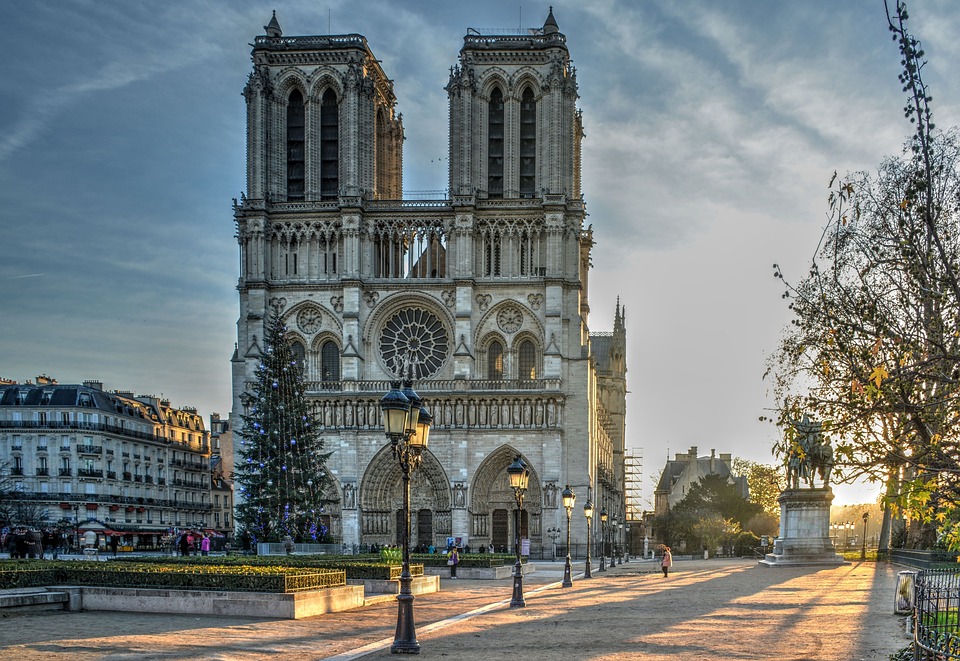There is an old paradox discussed by Heraclitus, that great ancient philosopher of impermanence, called “The Ship of Theseus.” It poses this question: “Consider a ship that has, over its long lifetime, had every part replaced during its repair so that not even a single nail from its original construction remains. Is it still the same ship?”
There have been many solutions offered to this puzzle down through the centuries, and I can’t think of a moment where it’s more relevant to our generation than with the burning of Notre Dame. Already the international community is rallying and pledges towards its rebuilding are flowing in. The French president says that it will be “more beautiful than ever.” Yet will it be the same cathedral? Will it be Our Lady? Or will it be a replica, such as the pseudo-Cave of Lascaux, the reproduction of the original Paleolithic temple created to protect the original from destruction by tourist hordes? Beautiful, yes, but not the Cave.
Of course, our own bodies contain not a single molecule of our original version while purportedly containing atoms that once helped embody Shakespeare, Hitler, and Alexander the Great’s mortal frames, so from the perspective of this radical impermanence, all things really are essentially empty and utterly interconnected. Yet it’s impossible to shake that sense of continuity, of the accumulation of something called a “soul,” that remains the Ship of Theseus, even after all its timbers, ropes, and sailcloth have been replaced. It’s the “aura,” as the philosopher Walter Benjamin called it, which is accumulated through time and which cannot be replaced by “mechanical reproduction.”
The outpouring of grief over the immolation of Notre Dame is because, I believe, millions of us venerated Her as not just the heart of France, but as “ensouled.” For many of us, regardless of religious background and creed, She was a living being who we loved, with whom we had a personal relationship that has graced our existence.
I would like to share a story of Notre Dame that I hope will illustrate why.
When I was a young writer, I came to France and was fortunate to stay at George Whitman’s towering, overflowing bookstore, Shakespeare and Co, located across the Seine from the cathedral. He welcomed young dreamers on pilgrimage, and gave me my own quarters with a key, so I could roam Paris at will. It was winter, so there were few tourists about to clutter up the ancient city.
I had, of course, made a bee-line to the cathedral and returned day after day to stroll its ambulatory beneath the arched vaults and gaze up into its great mandala of stained glass, seized by that rare feeling of happiness that comes from discovering an unsuspected home outside of one’s own biographical time.
My own little line in the great book of stories woven into the Cathedral came one night when a friend and I entered through the great wooden doors at dusk. There was a Mass underway in the nave in front, celebrated by a bishop with a Kiwi accent. We walked past the assembled worshippers and, finding access to the apse barricaded, we slipped around it and went to sit in the pews of the Lady Chapel in the back. It was dark, and the light of Paris spilled in through the exquisite stained glass that had survived there since the Middle Ages (does it still? I don’t know).
My friend and I talked quietly, until I realized that the distant sounds were of the closing of the cathedral. Turning to my friend, I said, “They don’t know we’re here! We could spend the night, you know.”
She stood up and said, “Do you want to do that?”
I nodded. “Yes!”
“Then I’ll see you in the morning,” she said, and the damsel fled back down the trail out of the stone forest just like in the fairytale.
I lay down quietly on the wooden bench, mimed sleep, and listened with every nerve aquiver. I heard the final shutting of the massive doors, the sound of receding voices and clatter, and then stillness descend into the cavernous space.
An hour passed, filled with a wonder of light, color, and marvelous forms, and then more wonder that I was before the altar where knights once had held vigil centuries before. I also lay listening for a watchman’s radio, a cough, a sound of footsteps, but there was only the silence of the stone and the vague rumblings of traffic outside.
Finally, I crept out to investigate. I was truly alone. I had been given the gift of a night in the Cathedral. I spent it in walking meditation, sitting and gazing, lying and dozing on the great heating vents that staved off the Parisian winter, and praying as best I knew.
Towards the morning, I began to take stock of my predicament. Search as I might, I could find no hidey-hole, and my being discovered in the morning would be awkward, at best. This led to my exploration of the heavy wooden cathedral doors, which boomed in a most satisfying fashion when tested, but wouldn’t open. Arriving at my last chance in the southern transept, I found with delight a cotter pin, which upon being removed allowed me to soundlessly swing open the heavy door.
There stood a German Shepherd, as surprised to see me as I was it. It was a mere ten feet away and might set up a ruckus. We gazed at one another, wondering what was to happen next.
Then I thought, “It’s a French dog. It can’t be bothered to bark.”
D’accord, it seemed to agree. “We French dogs have got better things to do than bark,” and lay quietly back down in its yard.
After leaping two high gates, I landed in the central plaza before the Cathedral. It was around 4 in the morning, and there was no one about. After a last, long look at its façade and trying to catch a glimpse of the gargoyles in its towers, I returned to get a little sleep at Shakespeare and Co.
In the morning, over coffee, I narrated my adventure to my friends at the bookstore. One of them said to me, “Do you have any idea the worth of the artwork and relics in there? Do you realize what treasures are stored in that cathedral?”
I hadn’t. It had never occurred to me. I now believe that if I had entered the cathedral that evening harboring such thoughts, I would have been quickly detected and escorted out. It was my very innocence and naivete that had protected me.
But it also hadn’t occurred to me that there might have been security cameras inside. A manhunt might be going on even now. It wasn’t a good time in French/American relations, and I could imagine how my escapade might turn into an international incident – as well as bring the authorities down on George Whitman. I determined to go and surrender, if such was to be my fate.
Imagine my relief, therefore, when I walked back into the cathedral and, carefully studying its interior, found not a single security camera. No Interpol agents leapt upon me either.
I love France, I thought.
Even more, I loved Notre Dame, and trace back that evening in meditation and prayer before the altar of Our Lady to my conversation to Marion worship. As a descendant of Protestant/Atheist stock, I had always thought the worship of the Virgin Mary to be a strange historical aberration, but it wasn’t long before I began to have experiences of Her love that surpasses understanding and became Her “knight” indeed.
Yes, it’s a story. That’s right. But a cathedral like Notre Dame isn’t made of glass, stone, and timber so much as stories. That is its patina of age, its aura of sacredness, its unfathomability in the realm of spirit. It is why Her immolation is like a meteor strike to ground zero of the human spirit.
And this is where the Ship of Theseus paradox comes in. The answer is: “Yes, one hundred years later, it is the same ship, if it was loved and maintained continuously in the same spirit. It will have grown and matured and gotten character, but its identity wouldn’t have changed.”
Notre Dame was built by hand over a span of nearly two hundred years. The generation that laid its foundation stones never expected to see its completion, and the aspirations and prayers (and zealousness and cruelty and covetousness and zaniness and all the other things that go in to making us human) of that intergenerational act of sustained, collective love for Our Lady were inscribed upon Her. Those stories are more essential to her identity than the beauty of her architecture.
That is the risk we run in rebuilding Notre Dame. She will no longer be the Cathedral that we loved, but a mechanical reproduction, a Disneyland replica. “More beautiful than before,” but without Her soul intact.
It may be best to sanctify her scorched shell instead. To turn it into a true sanctuary, a hortus conclusus or enclosed garden, a teaching of the noble truth of impermanence. Let us cover it with a great pavilion, open to the elements, and allow a little wild nature to return to the heart of Paris.
We might then use the hundreds of millions of dollars pouring in for her reconstruction to follow Christ’s core teaching to care for the poor and dispossessed instead.
That, perhaps, might be a more acceptable offering to Her.














